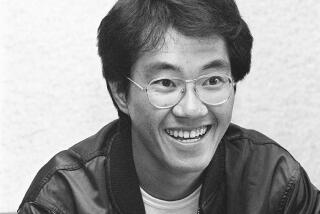Yoshihiro Tatsumi dies at 79; cartoonist who chronicled postwar Japan
Yoshihiro Tatsumi, a Japanese cartoonist who expanded the boundaries of graphic storytelling with gritty tales rooted in the frustrations and disappointments of ordinary people in post-World War II Japan, died March 7 in Tokyo. He was 79.
His death from cancer was confirmed by Peggy Burns, a spokeswoman for Drawn & Quarterly, the artist’s English-language publisher.
Although he began publishing as a teenager in the 1950s, Tatsumi gained wide attention in the West only in the last 10 years, particularly with the 2009 release of “A Drifting Life,” his highly praised graphic novel-cum-memoir.
In that work Tatsumi combined Japanese popular culture after the war with his personal story as a pioneer of the alternative comic style called gekiga. Japanese for “dramatic pictures,” gekiga became a flourishing subgenre of Japanese comics or manga, exploring alienation, sexuality, violence and other mature themes.
“Tatsumi was on the front lines of a movement to take the language of manga (which had previously focused more on action and fantasy) and use it to tell dark, realistic stories about regular people,” Adrian Tomine the cartoonist who serves as Tatsumi’s editor and designer, wrote in an email Friday. “I think in almost every way his work is the antithesis of the escapist material that has stereotypically been associated with comic books for generations, and the art form is far richer for it.”
Tatsumi’s stories were populated by working-class characters whose suffering brings more pain: A factory worker cripples himself to collect insurance, a prostitute ends her relationship with her good-for-nothing father by having sex with him, and a laborer burns down his own house to punish an abusive wife.
This dark view emerged in the 1960s when the artist found himself drawn to news reports that revealed the underside of life in a country undergoing rapid change, with thousands of youths moving to cities for jobs that paid poorly despite a rebounding economy. They became a prime audience for the kind of story Tatsumi wanted to tell.
“I didn’t want to write bright things, they were just not true,” Tatsumi told Singapore’s Straits Times newspaper in 2010. “The Japanese economy was going well, but my life and those of ordinary Japanese workers were not changing. There was a lot of anger and bitterness … and I was writing and drawing all these stories to reflect how I felt and to release my frustrations.”
Although it took three decades for his graphic stories and novels to reach a wide Western audience— “The Push Man, and Other Stories” and “Abandon the Old in Tokyo,” were originally published in Japan in 1969 and 1970, respectively—his themes resonated with contemporary audiences.
“It’s been over 30 years since these stories came out,” critic Carlos Santos wrote in a review of “Abandon the Old in Tokyo” for Animé News Network, “but the main themes, such as companionship, self-worth and family, are still universal issues today.”
Born in Osaka on June 10, 1935, Tatsumi was one of four children in a poor family. He was 10 when the atom bomb was dropped on Hiroshima.
His parents ran a laundry but often could not afford to pay for his schooling, so he passed the time in comic book shops. He was in junior high when he met one of his idols, comic artist Osamu Tezuka, who encouraged him to draw.
Tatsumi found creating comics exhilarating. “There was no freedom in reality,” Tatsumi wrote in his memoir, in which he turns himself into a character named Hiroshi. “The creative act of making something from nothing allowed him to live in an infinitely free world.”
By his early teens his work was appearing in “rental manga,” cheaply produced comics collections that readers borrowed from stores for a fee, like video rentals. His work, with its wild action and punch lines, was aimed largely at a juvenile audience.
As he matured, however, so did his approach to the art form. Influenced by filmmakers like Akira Kurosawa and the hard-boiled crime fiction of Mickey Spillane, he began to experiment with “manga that isn’t manga.” He drafted a “Gekiga Manifesto” in the late 1950s that helped launch the movement that took Japanese comics in a starkly different direction.
His memoir, the 855-page “A Drifting Life,” opens with a panel depicting Emperor Hirohito’s surrender. It moves on to scenes depicting important moments in Japanese pop culture, such as the introduction of Coca-Cola, and personal milestones, such as his realization in the 1960s that the element missing from his comics was anger.
He was working on a second autobiographical volume before he died. An excerpt will be published in June in the anthology “Drawn & Quarterly: Twenty-Five Years of Contemporary Cartooning, Comics and Graphic Novels.”
Tatsumi’s survivors include his wife, Eiko, and a sister, Michiko Tatsumi.
Twitter: @ewooLATimes
More to Read
Start your day right
Sign up for Essential California for the L.A. Times biggest news, features and recommendations in your inbox six days a week.
You may occasionally receive promotional content from the Los Angeles Times.







